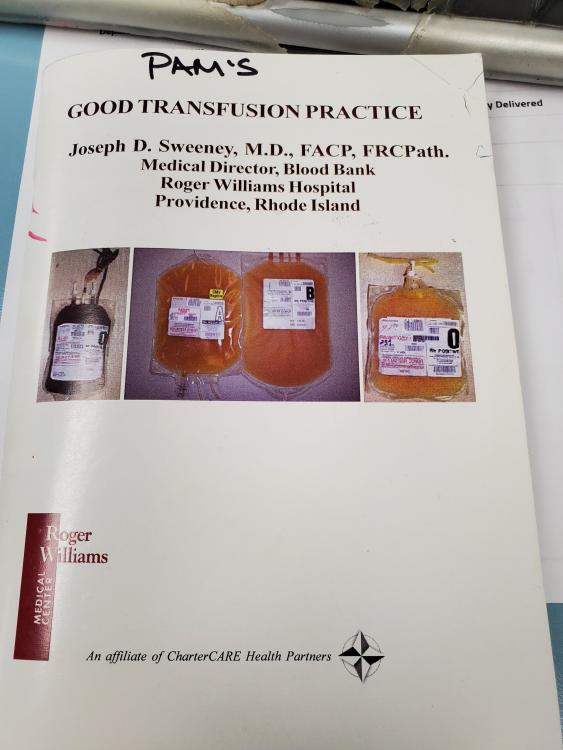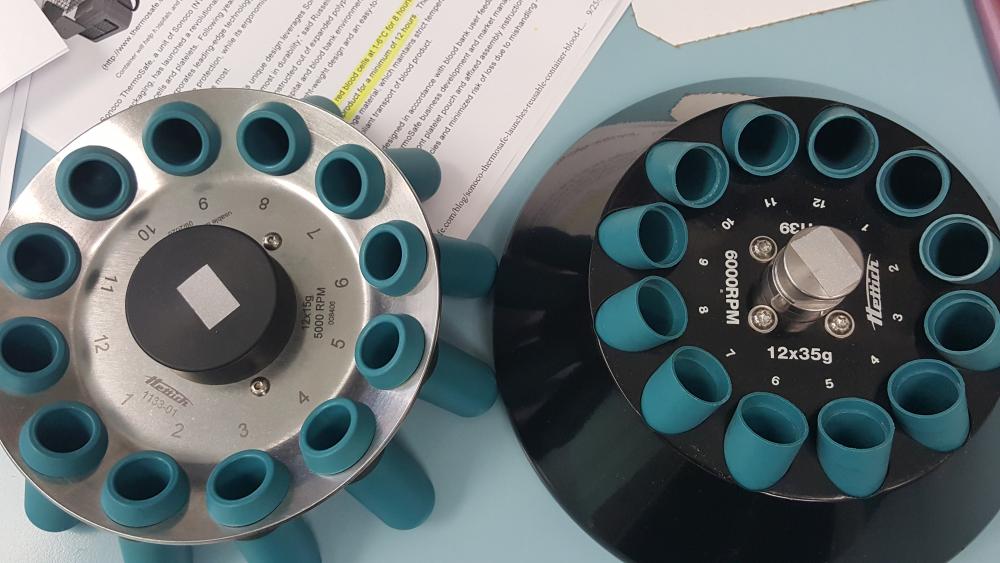Content Type
Store
Profiles
Forums
Blogs
Events
Frequently Asked Questions
Gallery
Downloads
Glossary
Links Directory
Questions
Jobs
Vendors
Everything posted by PammyDQ
-
Hi Cliff, In response to the email reaching out for posts, I decided to log in again. I began in the group 15 years ago when it was Blood Bank Talk. It'd been a while since I logged in so I had to re sign in thanks to your prompt. I am 99% sure I had always used my user name to sign in, not email, but I was not allowed to enter anything that in the field without an "@" . I tried my email addresses unsuccessfully. I was able to gain access by doing a password reset and was then automatically in. I went to edit profile and I don't even see my email address to update as it was changed by our hospital (but I can still receive mail sent to old address as it automatically goes into the new mail) I do appreciate this site, but will admit I'm distracted by pages on the social media platforms where I spend more time. I suspect I'm not alone here.
-

BloodBankTalk: Blood Transfusion Therapy in Haemoglobinopathies
PammyDQ replied to Cliff's topic in Question of the Day
I just answered this question. My Score PASS -
I am answering the moderator's call to answer lingering unanswered posts. So here I go... Our thresholds vary by circumstance. We do marrow and stem cell transplants and have an active cancer center, therefore use a lot of platelets. Conservation is imperative so we strictly monitor their use. For the autologous transplants, our criteria for prophylactic platelet transfusion is <5. For allogeneic it's <10. We also use the immature platelet fraction to determine whether the patient's marrow is recovering which might lead us to being more conservative if they're trending up. If they're febrile, septic, bleeding, having an invasive procedure, on certain anticoagulents then they may raise the threshold. Some non-BMT oncologists are more liberal with platelet transfusions for their outpatients, often using 20 as a minimum. For the general patient population, we are also restrictive, but try keep transfusions below 10. But again, the overall picture will determine if we choose to question/restrict their order. For ITP, we suggest no platelet transfusion unless they're bleeding. They need to be treated with corticosteroids. Our Medical Director publishes a pocket guide with many different aspects of transfusion medicine. Data is based on Circular of Information, standards, peer reviewed studies, AABB, FDA, etc. It's given to the house staff every year. It's very handy and we can remind the docs to check page so-and-so if they order something we question.
-

Sudden Onset Hemolysis with weakened D antigen
PammyDQ replied to applejw's topic in Immunohematology Reference Laboratories
It's very common for a weak/partial D person to react strongly with gel and weak or negative with I.S. tube method. I even had one today! Remember, the reagent anti-D in your bottle and the anti-D in your Monoclonal ABD card are not from the same clones used in manufacturing. And it's not the methodology because before the prepared monoclonal ABC cards we used to make our own with the buffered gel cards...but didn't see the different reaction patterns until patients returned after us getting the monoclonal cards. And now we do our 2nd confirmatory with 2nd specimen by tube method so we see patients with "discrepant" strengths when they're a weak D. That said, with a 4+ in gel (your subsequent workup) and a 1+ in tube (from the initial workup) I would venture to guess the child is a weak or partial D. Next issue...As far as the 1st case of gel testing shown, with the agglutination with Anti-A, Anti-B, anti-D and the control, I suspect the diluent. I've been using gel for greater than 16 years, yet over the past couple years we're having problems with the Ortho Diluent 2 getting funky at the end, and reacting exactly like that, sometimes only affecting one specimen in the batch. It's possible if you made a new suspension with fresh diluent you may have not seen that and the typing was unrelated to the antibody screening. Or perhaps the patient cells needed washing because they were coated with whatever was causing your positive screen. So, my suspicion is that the child had a typical case of WAIHA that had nothing to do with his D type, and he was successfully treated with steroids and/or other drugs before returning for the follow-up workup. -

Bendamustine and irradiated blood products
PammyDQ replied to goodchild's topic in Transfusion Services
Hi Mabel, sorry for the extreme delay. I believe our patient population only receives these drugs in our Cancer Center's infusion center in another building on campus, and those are dispensed by our pharmacy. Of course there's always a risk with an "outside" patient, but in reality it's always the prescriber's responsibility to order the correct blood products for their patients. What we do goes over and above because we are very involved with our patients' care and do our best to support the docs in their treatment of the patients. -
I'm just getting back to this...2 years later. I erred...it's a Hettitech EBA280. The former model was FA. They are marketed with different application packages for different lab uses, but I basically ordered what we wanted a la carte. We have our centrifuges set for different RPM's and different times for different purposes. You can create up to 9 combinations to be preset. It's a pain to do though. Our serology rotor is set at 3500 for testing (max for the head is 5000), and the larger specimen rotor is set for 6000 for sample separation (max is 6000). The centrifuge will not allow the rotors to exceed their max. Also notice I've removed the thingies that hold the tubes tight in the "washing" fixed rotor (as opposed to the swing out rotor). The purpose is to keep the tubes from falling out while decanting with manual washes. Their a bit tight and a nuisance and since we don't really need them I removed. I'm looking at the Hettitech site now and I see they've reconfigured some of their application packages, but I'm still not thrilled with the Blood Bank one. 6 tube slots are not enough IMO. Overall they work good. Programming is a PIA but as long as no one accidentally hits wrong buttons and changes it once it's set you won't have to mess with it.
-
It's been a VERY long time since I've done neonatal blood banking, Steve was correct as usual to cite the regulations. And kudos to Malcolm for the correction on their improper terminology...I didn't catch that! That said... In this hypothetical scenario, there is no mention whether the anti-c is Ig-M, Ig-M & Ig-G or Ig-G exclusively, and depending on the methodology used you may not know. I'll assume we're talking Ig-G only. This would make me believe that mom had a low/undetectable titer of anti-c from a previous sensitization which was spiked by this pregnancy/birth (assuming mom wasn't transfused at delivery) and subsequently detected a week later. So, that would lead me to believe that baby is in fact c+. Since mother's screen was negative at birth, any maternal antibodies in the baby's circulation would be at a very low titer if any were present at all, evident by the negative DAT. Baby would also have a negative antibody screen. This would exclude the necessity of transfusing c- negative units. If in this scenario they wanted to transfuse the baby at a week old, could not obtain a baby T&S, and mom's current blood was used for pre-transfusion workup/crossmatch, THEN you'd need to honor her antibody in order to have compatibility with mom, and hence transfuse baby c- RBCs. (In my experience with neonates at 3 facilities, any baby requiring transfusion would have a Type & Screen performed on their own peripheral blood, we never used mother's.)
-
We have 2 brand new Hettitech/Helmer SeroSpin®-FA-280s. The FA rotor has a maximum of 5000 rpm but we're using 3500 for serological testing. We also purchased a separate 12 place blood separation rotor to use for spinning the samples (we spin at the bench). The maximum RPM for that extra head is 6000 and we have ours set to spin at 5000 for 5 minutes and get nice separation. The centrifuge knows which head is in. I've never heard of a 80,000RPM centrifuge! That's crazy fast! Or a typo?
-

Bendamustine and irradiated blood products
PammyDQ replied to goodchild's topic in Transfusion Services
We are a community hospital with a bone marrow/stem cell/cord blood transplant center. Our blood bank medical director is Dr. Joseph Sweeney (you can look up his illustrious credentials). He has recommended that patients receiving fludarabine, bendamustine, claradibine, deoxycoformycin, alemtuzumab, anti-CD52, and campath within 2 years should receive irradiated blood products, but made our policy that they receive irradiated products for life. We usually only deal with fludaribine, but lately bendamustine is being seen a lot. While the transplant team includes blood bank in their weekly meetings, sometimes communicating the meds can be missed. We now have a program in our HIS that when the pharmacy is dispensing these drugs, a printout comes to blood bank so we know and we put an irradiated product marker in our LIS. -
I am catching this topic as my shift ends and am unable to read it now. I will be in Denver, we have a poster presentation. I'm posting this so I get updates in my email, and hopefully can catch up on this topic tomorrow!
-

Joint Commission: New Certification for Blood Management
PammyDQ replied to tbostock's topic in Accrediting Agencies
Hi Terri, I just heard this morning that the JC has requested our hospital to be a possible trial(?) site, and an informal visit is scheduled for the 18th. I don't have details yet, and I'm off that day. I'm told that the program entails much how how we've been operating here for several years. More to follow..... Pam -
I agree with using the 'scope to verify what you're suspecting macroscopically. I like using an agglutination viewing mirror. A reference tech I once worked with said it well...the microscope should be a tool, not a crutch. Unfortunately the current SOP I must follow requires microscopic confirmation of negatives. As an experienced tech, I choose to test in duplicate and use my best judgement whether or not it's necessary.
-

performing ABORh on Stem Cell aliquot
PammyDQ replied to PammyDQ's topic in Tissue, stem cells, and bone marrow
Peter, please explain what you mean by "dissolve (maybe wait 5 minutes)". Thanks! -
Prior to a HSCT transplant our blood bank receives 2 specimens for ABO Rh from the donor. One is peripheral, the other is an aliquot from the actual stem cell collection. For many samples upon centrifugation of the stem cells, there is barely a cell button of rbcs remaining. We do MTS gel testing & only need 10ul of cells. When aspirating the rbcs at the bottom of the cell button, they become contaminated with stem cells, and any gel typing is junky looking and the control usually comes out positive. We often end up using an extremely dilute specimen and perform tube typing, disregarding the flocculation caused by the stem cells and make an educated decision by the most experienced techs of the blood type (which we have already presumed from the peripheral specimen). Increasing our sample aliquot would deplete the volume of cells to be transplanted, so that is not an option. Does anyone else have this problem or a better way of performing ABORh's on stem cell aliquots?
-
What regulation did JCAHO cite to not allow refrigerator in OR? I've worked at several hospitals with Blood Bank refrigerators and they were all compliant. Were they not monitored?
-
Yeah that is scary! We had a patient die of a TRALI reaction with a perfectly justified FFP transfusion. The FDA was ALL OVER US with a fine tooth comb and a microscope probing every tiny detail from every angle they possibly could. Imagine is something like that happened in this "nutritional" need case?
-

historical and present blood groups don't match
PammyDQ replied to janet's topic in Transfusion Services
I saw a nightmare like this when patients with the same name and similar DOB were merged into one record and one person's demographics was replaced with the other's! Fortunately they had different blood types and this is how it was discovered. Medical records and IS had to go through all the data and separate it back to 2 different patients. I have also heard of a case where someone loaned their insurance card to an uninsured friend that went to another facility to obtain covered health care...they didn't know it could be traced because the facilities were linked and their blood types differed! Patient identity can sometimes be deceiving...almost...and I learned never to assume. I once worked on 2 specimens days apart from an OB clinic. It seemed like a duplicate order because one was named Janice "Doe" and one was named Janet "Doe". Both had the same doctor, home address and DOB. When I called to inquire at the clinic as to whether it was a duplicate order, they said no, they're TWINS!!! (did their parents not think in the future there could be identity problems???!!!) -
It's a universal problem with the occasional uneducated and/or rude physician. If you were rude to him, there surely would be an incident report filed against you. Physicians are NOT exempt from formal complaints being filed against them...and I know from experience when it is done it sure does tame them! If he was willing to sign for emergency release blood I would include in big bold letters UNIT IS LIKELY INCOMPATIBLE with patient...I've seen plenty of docs suddenly realize their situation is not as urgent as they initially thought when they have to sign for responsibility, even after they were screaming they needed it immediately.
-
Gee Phil, sounds like a same patient I did here at RWMC a few weeks ago...but our guy is AB+. I guess there's 2 of them walking around the area right now!
-
Joseph D. Sweeney MD (from RI, there is another one elsewhere) born raised and educated on YOUR side of the pond, Malcolm
-
LOL I'd make a lot of money if I could clone ANY human! But seriously he is a gem, always taking time to explain/educate the hows and whys things to the BB techs and the medical staff (he's a walking encyclopedia of immunohematology & coagulation facts and figures). He's a similar to a "consultant" here, pops in a couple hours a day(or less), yet accessible 24/7/365 no matter where in the world he is. He is the full time director of 2 other local hospitals in a different system than ours. He is well published and conducts research studies freqently (see us in TRANSFUSION soon) and gives/attends lectures nationally and internationally. We're very lucky that he has our backs in ANY transfusion medicine situation!!! Keeps the "stupidity" to a minimum. I don't know if I would want to work in any other situation now that I'm accustomed to this level of support...it ought to be a requirement!
-
This is why my facility is lucky to have an great medical director...that NEVER would have happened. He would educate the ordering physician and put him right in his place. We get these antibody situations not uncommonly and it always works out whether the blood is incompatible or the transfusion is averted, which is often the case.
-
It's mentioned in this case study I found by Googling... http://path.upmc.edu/cases/case575.html
-
This is what we do...in most cases we can find a hematology specimen from a different collection time. If not, as in new admits or ER patients, we will kindly ask for "a tiny bit" of blood in a lavender tube. For our pre-op patients that have no history, we call the pre-admission testing department the day before surgery and they collect a confirmation specimen when they start the patient's IV. In any case, if we're unable to confirm a non-O patient's type, we will transfuse O red cells. This happens RARELY.
-
You know...when TV shows would "blame the lab" for major errors, I would get angry because we really do a spectacular job as technologists. After reading about some of these techs/students and their misinformed way of doing things (ie. totally against protocol)...I'm thinking differently! LOL...scary!! Perhaps these are the techs that are "afraid" of working in blood bank/transfusion services because they're afraid of killing a patient by their errors? You know the ones I'm talking about, don't you?!!



